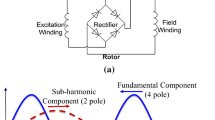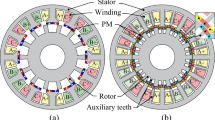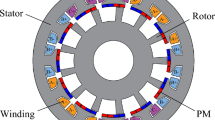Abstract
In this paper, the reluctance torque is utilized for improving the starting and average torques of a conventional brushless wound field synchronous machine (BL-WFSM). The conventional BL-WFSMs have an inherent issue of zero-starting torque. The existing BL topologies use expensive rare-earth permanent magnets (RE-PMs) to improve the starting torque; however, the marker price of RE-PMs fluctuates. Therefore, this paper proposes the use of the reluctance torque for improving the starting and average torques of BL-WFSMs. The winding topology and machine layout are adopted, from recently published work. The suggested approach increases the reluctance effect in BL-WFSM by optimizing the rotor shape. The reluctance effect is optimized, to improve the starting and average torques. The Kriging method and a genetic algorithm are used for the rotor optimization. A two-dimensional finite element analysis confirms the improved starting and average torques based on the increase in the reluctance torque.








Similar content being viewed by others
References
Amara YC, Vido L, Gabsiet M et al (2009) Hybrid excitation synchronous machines: energy-efficient solution for vehicle propulsion. IEEE Trans Veh Technol 58(5):2137–2149
Chu KH, Pou J, Ramakrishna S, Gupta AK (2017) Performance of series hybrid excitation synchronous machine in comparison with wound field synchronous machine. In: 2017 Asian Conference on Energy, Power and Transportation Electrification (ACEPT), Singapore, pp. 1–6
Legranger J, Friedrich G, Vivier S, Mipo JC (2010) Combination of finite-element and analytical models in the optimal multi domain design of machines: application to an interior permanent-magnet starter generator. IEEE Trans Ind Appl 46(1):232–239
Duan Y, Ionel DM (2013) A review of recent developments in electrical machine design optimization methods with a permanent-magnet synchronous motor benchmark study. IEEE Trans Ind Appl 49(3):1268–1275
Alotto P, Barcaro M, Bianchi N, Guarnieri M (2011) Optimization of interior PM motors with mechanic rotor flux barriers. IEEE Trans Magn 47(5):958–961
Hur J, Reu JW, Kim BW, Kang GH (2011) Vibration reduction of IPM-type BLDC motor using negative 3rd harmonic limitation method of air-gap flux density. IEEE Trans Ind Appl 47(3):1300–1309
Wang Y, Luo R, Zheng Y (1978) The analysis of harmonic excitation on turbo generator. J Zhejiang Univ 1:91–114
Jawad G, Ali Q, Lipo TA, Kwon BI (2016) Novel brushless wound rotor synchronous machine with zero-sequence third-harmonic field excitation. IEEE Trans Magn 52(7):1–4
Yao F, An Q, Gao X, Sun L, Lipo TA (2015) Principle of operation and performance of a synchronous machine employing a new harmonic excitation scheme. IEEE Trans Ind Appl 51(5):3890–3898
Ayub M, Atiq S, Sirewal GJ, Kwon B (2019) Fault-tolerant operation of wound field synchronous machine using coil switching. IEEE Access 7:67130–67138. https://doi.org/10.1109/ACCESS.2019.2918504
Ayub M, Hussain A, Jawad G, Kwon B (2019) Brushless operation of a wound-field synchronous machine using a novel winding scheme. IEEE Transactions on Magnetics. https://doi.org/10.1109/TMAG.2019.2893883
Ali Q, Atiq S, Lipo TA, Kwon BI (2016) PM assisted, brushless wound rotor synchronous machine. J Magn 21(3):399–404
Ayub M, Jawad G, Kwon B (2019) Consequent-pole hybrid excitation brushless wound field synchronous machine with fractional slot concentrated winding. IEEE Trans Magn 55(7):1–5. https://doi.org/10.1109/TMAG.2018.2890509
Hwang S, Sim J, Hong J, Lee J, Kim J (2016) Torque improvement of wound field synchronous motor for electric vehicle by PM-assist. In: 2016 IEEE Energy Conversion Congress and Exposition (ECCE), Milwaukee, WI, pp. 1–6
Fukami T, Matsui Y, Hayamizu T, Shima K, Hanaoka R, Takata S (2008) Steady-state analysis of a permanent-magnet-assisted salient-pole synchronous generator. In: 2008 18th International Conference on Electrical Machines, Vilamoura, pp. 1–6
Liu W, Lipo TA (2016) On saliency enhancement of salient pole wound field synchronous machines. In: 2016 IEEE Energy Conversion Congress and Exposition (ECCE), Milwaukee, WI, pp. 1–8
Chai W, Zhao W, Kwon B (2017) Optimal Design of Wound Field Synchronous Reluctance Machines to Improve Torque by Increasing the Saliency Ratio. IEEE Trans Magn 53(11):1–4. https://doi.org/10.1109/TMAG.2017.2707459
PIAnO outline [Online]. http://www.pidotech.com/en/product/PIAnO.aspx. Accessed August 2019
Acknowledgement
This work was supported by the Korea Institute of Energy Technology Evaluation and Planning (KETEP) and the Ministry of Trade, Industry & Energy (MOTIE) of the Republic of Korea (No. 20174030201780), and in part by the BK21PLUS Program through the National Research Foundation of Korea within the Ministry of Education.
Author information
Authors and Affiliations
Corresponding author
Rights and permissions
About this article
Cite this article
Ayub, M., Bukhari, S.S.H., Jawad, G. et al. Utilization of reluctance torque for improvement of the starting and average torques of a brushless wound field synchronous machine. Electr Eng 103, 2327–2333 (2021). https://doi.org/10.1007/s00202-020-01174-5
Received:
Accepted:
Published:
Issue Date:
DOI: https://doi.org/10.1007/s00202-020-01174-5




